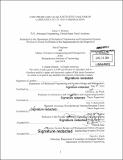| dc.contributor.advisor | Olivier L. de Weck, Eric S. Rebentisch and Mark W. Thomas. | en_US |
| dc.contributor.author | Dobson, Aaron T. (Aaron Travis) | en_US |
| dc.contributor.other | System Design and Management Program. | en_US |
| dc.date.accessioned | 2014-10-08T15:30:36Z | |
| dc.date.available | 2014-10-08T15:30:36Z | |
| dc.date.issued | 2014 | en_US |
| dc.identifier.uri | http://hdl.handle.net/1721.1/90810 | |
| dc.description | Thesis: Nav. E., Massachusetts Institute of Technology, Department of Mechanical Engineering, 2014. | en_US |
| dc.description | Thesis: S.M. in Engineering and Management, Massachusetts Institute of Technology, Engineering Systems Division, System Design and Management Program, 2014. | en_US |
| dc.description | "June 2014." Cataloged from PDF version of thesis. | en_US |
| dc.description | Includes bibliographical references (pages 76-80). | en_US |
| dc.description.abstract | As the sophistication and technology of ships increases, U.S. Navy shipbuilding must be an effective and cost-efficient acquirer of technology-dense one-of-a-kind ships all while meeting significant cost and schedule constraints in a fluctuating demand environment. A drive to provide world-class technology to the U.S. Navy's warfighters necessitates increasingly complex ships, which further augments the non-trivial problem of providing cost effective, on-schedule ships for the American taxpayer. The primary objective of this study was to quantify, assess, and analyze cost-predictive complexity-oriented benchmarks in the pre-construction phase of the U.S. Navy's ship acquisition process. This study used commercially-available software such as Mathwork's MATLAB software to analyze the numerical cost data and assess the fidelity of the predictive benchmarks to the datasets. The end result was that a consideration of complexity via the methods and algorithms established in this study supported an exponential cost versus complexity relationship to refine the current cost estimation methods and software currently in use in U.S. Navy shipbuilding. Specifically, it was found that for the subsystems under analysis, acquisition/contract cost per unit was highly correlated with unit complexity according to the relationship, cost/unit ($M,USD) = 23.100 + e 0.015C. | en_US |
| dc.description.statementofresponsibility | by Aaron T. Dobson. | en_US |
| dc.format.extent | 111 pages | en_US |
| dc.language.iso | eng | en_US |
| dc.publisher | Massachusetts Institute of Technology | en_US |
| dc.rights | M.I.T. theses are protected by copyright. They may be viewed from this source for any purpose, but reproduction or distribution in any format is prohibited without written permission. See provided URL for inquiries about permission. | en_US |
| dc.rights.uri | http://dspace.mit.edu/handle/1721.1/7582 | en_US |
| dc.subject | Mechanical Engineering. | en_US |
| dc.subject | Engineering Systems Division. | en_US |
| dc.subject | System Design and Management Program. | en_US |
| dc.title | Cost prediction via quantitative analysis of complexity in U.S. Navy shipbuilding | en_US |
| dc.type | Thesis | en_US |
| dc.description.degree | Nav. E. | en_US |
| dc.description.degree | S.M. in Engineering and Management | en_US |
| dc.contributor.department | System Design and Management Program. | en_US |
| dc.contributor.department | Massachusetts Institute of Technology. Department of Mechanical Engineering | |
| dc.contributor.department | Massachusetts Institute of Technology. Engineering Systems Division | |
| dc.identifier.oclc | 891655247 | en_US |
